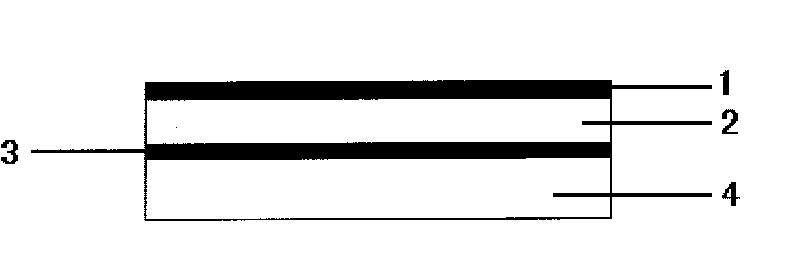Radiation protective film material and application thereof
A thin film material and anti-radiation technology, applied in the field of anti-radiation, can solve the problems of poor coating or adhesion performance, poor microwave absorption performance, etc., and achieve good electromagnetic absorption performance, good transparency, and wide application effects
- Summary
- Abstract
- Description
- Claims
- Application Information
AI Technical Summary
Problems solved by technology
Method used
Image
Examples
Embodiment 1
[0027] First prepare the electromagnetic shielding coating material, and its preparation method is as follows:
[0028] (1) Polystyrene (PS) was mixed with 98% concentrated sulfuric acid and stirred for 25 hours to obtain a sulfonated polystyrene (SPS) template;
[0029] (2) At room temperature, use the oxidant ammonium persulfate to polymerize the aniline monomer on the sulfonated polystyrene template to obtain sulfonated polystyrene polyaniline microspheres (SPS-PAn);
[0030] (3) Pass the polystyrene polyaniline microspheres (SPS-PAn) through the treating agent tetrahydrofuran to remove the coated polystyrene (PS) to obtain polyaniline hollow microspheres (abbreviated as HSPS-PAn);
[0031] (4) the hollow microspheres of described polyaniline and Ni 0.5 Zn 0.5 Fe 2 o 4 Ferrofluid reacts to Ni 0.5 Zn 0.5 Fe 2 o 4 / polyaniline hollow microsphere composite (HSPS-Pan / Ni 0.5 Zn 0.5 Fe 2 o 4 );
[0032] (5) Ni 0.5 Zn 0.5 Fe 2 o 4 Polyaniline hollow microsphere co...
Embodiment 2
[0035] As described in Example 1, at first, the electromagnetic shielding coating material is prepared, and its preparation method is as follows:
[0036] (1) Polystyrene (PS) was mixed with 98% concentrated sulfuric acid and stirred for 28 hours to obtain a sulfonated polystyrene (SPS) template;
[0037] (2) At room temperature, using the oxidizing agent FeCl 3 Polymerize the aniline monomer on the sulfonated polystyrene template to obtain sulfonated polystyrene polyaniline microspheres (SPS-PAn);
[0038] (3) Pass the polystyrene polyaniline microspheres (SPS-PAn) through the treating agent tetrahydrofuran to remove the coated polystyrene (PS) to obtain polyaniline hollow microspheres (abbreviated as HSPS-PAn);
[0039] (4) reacting the hollow microspheres of the polyaniline with the magnetic fluid to obtain Ni 0.5 Zn 0.5 Fe 2 o 4 / polyaniline hollow microsphere composite (HSPS-Pan / Ni 0.5Zn 0.5 Fe 2 o 4 );
[0040] (5) Ni 0.5 Zn 0.5 Fe 2 o 4 / polyaniline hollow...
Embodiment 3
[0045] The invention discloses anti-radiation glasses made of anti-radiation materials, including brackets and lenses, wherein the structural schematic diagram of the lenses is as follows figure 1 shown.
[0046] The lens consists of four layers, including glass or resin lens layer 4, adhesive layer 3, base film layer 2 and coating layer 1 bonded in sequence. The coating layer 1 is coated with the electromagnetic shielding coating material disclosed in the present invention on the bottom film layer 2, the bottom film layer 2 is a PET layer or a PE layer, and the adhesive layer 3 uses polyurethane as an adhesive After curing, the PET or PE layer and the lens layer 4 are integrated.
[0047] The anti-radiation spectacle lens disclosed by the invention is preferably green, and the prepared anti-radiation spectacle has excellent anti-radiation performance.
[0048] The anti-radiation film material of the present invention can be used not only on glasses, but also on computer dis...
PUM
 Login to View More
Login to View More Abstract
Description
Claims
Application Information
 Login to View More
Login to View More - R&D
- Intellectual Property
- Life Sciences
- Materials
- Tech Scout
- Unparalleled Data Quality
- Higher Quality Content
- 60% Fewer Hallucinations
Browse by: Latest US Patents, China's latest patents, Technical Efficacy Thesaurus, Application Domain, Technology Topic, Popular Technical Reports.
© 2025 PatSnap. All rights reserved.Legal|Privacy policy|Modern Slavery Act Transparency Statement|Sitemap|About US| Contact US: help@patsnap.com


